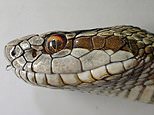
A new species of snake whose venom is so potent it can leave human victims disabled has been found in China.
The snake, Gloydius lateralis, was discovered in the Zharu Valley at Jiuzhaigou National Nature Reserve, a World Heritage Site in China’s Sichuan Province.
It feeds on small mammals, such as mice, and ‘is active on sunny days by the roadside in a hot, dry valley’, the researchers say.
The species had a small body of around 18 inches, large eyes, and is a murky green or brown colour with four rows of zigzag dark brown patches.
A continuous, grey-brown stripe runs down each side of the snake’s body and tail, which is why it has been named ‘lateralis’ (relating to ‘lateral’).
The snake feeds on small mammals, such as mice, and ‘is active on sunny days by the roadside in a hot, dry valley’
A new Chinese species of snake, Gloydius lateralis, has venom so potent it can leave human victims disabled, researchers say
JIUZHAIGOU NATIONAL NATURE RESERVE
Jiuzhaigou National Nature Reserve, a World Heritage Site, is in the transition zone from the eastern edge of the Qinghai-Tibet Plateau to the Sichuan Basin in Sichuan Province, China, and occupies an area of 651 km2.
The reserve is covered with well-preserved original forests, and numerous alpine lakes.
Beautiful and picturesque, it is home to some rare animals, such as the Giant Panda (Ailuropoda melanoleuca) and Golden Snub-nosed Monkey (Rhinopithecus roxellana).
Asked if the snake posed a threat to humans, Dr Shengchao Shi – one of the team who documented the new species – emphasised the potency of its venom.
He said: ‘The Gloydius lateralis is venomous. To our knowledge, all species of genus Gloydius are.
‘I don’t think its bite is mild. Bites by Gloydius are accompanied with lots of pain and may cause physical disability when not treated in time.
‘Their venom contains blood poison and can cause swelling, but most of the time, they are not lethal.
‘The effect of the venom of this species still needs further study.’
The experts had been conducting surveys in Jiuzhaigou National Nature Reserve when they collected some specimens of Gloydius, a genus of venomous pit vipers endemic to Asia, from Zharu Valley.
Gloydius are a genus in the Crotalinae subfamily, putting them alongside species like the notorious rattlesnake and the copperhead.
After running morphological and phylogenetic analyses, the scientists found out that these specimens in fact belonged to a yet-to-be-described species.
Dr Jingsong Shi, another scientist who contributed to the paper, added that the snake was similar to a known species, Gloydius swild, but with a few key differences.
Gloydius lateralis is active on sunny days by roadsides, posing the risk of collisions with cars
He said: ‘It differs by having larger eyes (related to the head) and a continuous regular brown stripe on each dorsolateral side of the body. ‘Thus, we named it after its unique colour pattern, Gloydius lateralis.’
The Jiuzhaigou national park, where G. lateralis was found, is already home to some rare animals including the giant panda and the golden snub-nosed monkey.
But despite the new discovery, it does not have a diverse snake population – perhaps because of the harsh alpine environment.
The snake, Gloydius lateralis, was discovered in the Zharu Valley at Jiuzhaigou National Nature Reserve, a World Heritage Site in China’s Sichuan Province. Pictured is the lush landscape in the reserve
The national park where the snake was discovered receives millions of visitors every year. And the only known habitat of the new species, the Zharu Valley, is now being developed for tourism.
‘Walkways for tourists have been built in the region, but some people are still venturing off of the walkways,’ the researchers say.
‘Thus, warning signs are still needed to remind visitors to watch out for the venomous pit viper, since this and another pit viper species, Protobothrops jerdonii, are often found in grass or bushes on both sides of roads.’
Snakes’ thermoregulation needs make them more prone to vehicle collisions, which is why the research team highlights the necessity to remind drivers to slow down in order to avoid killing them.
The new study was published in the open-access scientific journal ZooKeys.
BURMESE PYTHON WEIGHING 215LBS AND MEASURING NEARLY 18FT LONG FOUND IN FLORIDA
Deep in the swamps of Florida’s Picayune Strand State Forest lived a Burmese python so large that it took three men to carry it out of the Everglades.
Researchers at the Conservancy of Southwest Florida captured this massive female python that turned out to weigh 215 pounds and measure 17.7 feet long – deeming it the largest python ever recorded in Florida—or anywhere outside its native range.
Researchers found 122 proto eggs inside, which is the largest amount to be discovered in a female.
The giant snake was caught in December, euthanized and put on ice in a freezer until April. National Geographic’s Rebecca Dzombak traveled to a lab in Naples to watch the researchers perform a necropsy.
Read more
Source link
CHECK OUT: Top Travel Destinations
READ MORE: Travel News



